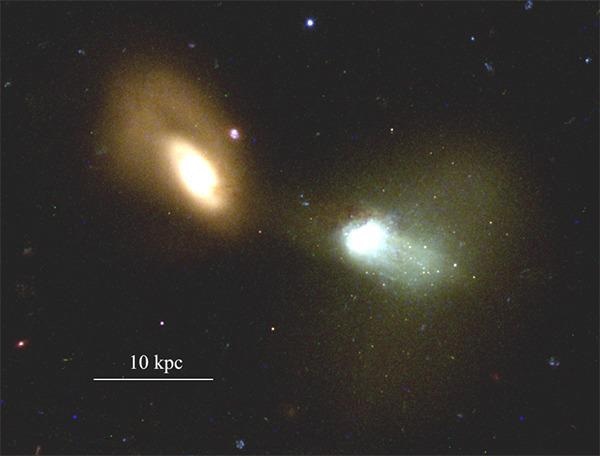For the first time in their scientific careers during the pandemic, a husband-and-wife team of astronomers from The University of Toledo joined forces to formulate a new technique to look back in time and modify the way the history of galaxies is understood.
 S12, a post-starburst galaxy located nearly 500 million light-years away, is on the right. It looks like a jellyfish with a host of stars streaming out of the galaxy on one side. (Image Credit: The University of Toledo).
S12, a post-starburst galaxy located nearly 500 million light-years away, is on the right. It looks like a jellyfish with a host of stars streaming out of the galaxy on one side. (Image Credit: The University of Toledo).
Until now, building parallel but individual careers while managing home life and carpooling to cross country meets, Dr. Rupali Chandar, professor of astronomy, and Dr. J.D. Smith, director of the UToledo Ritter Astrophysical Research Center and professor of astronomy, combined their areas of proficiency.
Working together with UToledo alumnus Dr. Adam Smercina, who graduated with a bachelor’s degree in physics in 2015 and is a postdoctoral researcher at the University of Washington, they made use of NASA’s Hubble Space Telescope to study a post-starburst galaxy referred to as S12 that is approximately 500 million light-years away and resembles a jellyfish with a multitude of stars spilling out of the galaxy on one side.
Starting in 2012, Dr. Adam Smercina, the “glue” that drew Smith and Chandar together on this exploration, worked with Smith as an undergraduate student on the gas and dust in post-starburst galaxies.
While spiral galaxies like the Milky Way have persistently formed stars at a steady rate, post-starburst galaxies underwent a strong burst of star formation sometime in the last half-billion years, halting their star formation.
The resulting innovative research reported in the Astrophysical Journal describes their new technique to prove the star-formation history of a post-starburst galaxy with the help of its cluster population. The method uses the age and mass approximations of stellar clusters to establish the speed and intensity of the starburst that halted more stars from being created in the galaxy.
Using this technique, the astronomers discovered that S12 underwent two - not one- periods of starburst before it stopped forming any more stars.
“Post-starbursts represent a phase of galaxy evolution that is pretty rare today,” Smith said. “We think that nearly half of all galaxies went through this phase at some point in their lives. So far, their star-forming histories have been determined almost exclusively from detailed modeling of their composite starlight.”
Smith has researched post-starburst galaxies for over a decade, and Chandar works on the stellar clusters in galaxies that are usually around three or four times closer than those in Smith’s data.
Clusters are like fossils—they can be age-dated and give us clues to the past history of galaxies. Clusters can only be detected in these galaxies with the clear-eyed view of the Hubble Space Telescope. No clusters can be detected in even the highest-quality images taken with telescopes on the ground.
Dr. Rupali Chandar, Professor of Astronomy, The University of Toledo
Smith has headed numerous large multiwavelength projects to better comprehend the evolutionary past of post-starburst galaxies. He learned, for example, that the raw fuel for star development — dust and gas — is still present in astonishing amounts in a few of these systems including S12, although no stars are being created.
While studying the light from these galaxies at multiple wavelengths has helped establish the time that the burst happened, we hadn’t been able to determine how strong and how long the burst that shut off star formation actually was. And that’s important to know to better understand how these galaxies evolve.
Dr. J.D. Smith, Professor of Astronomy and Director, Ritter Astrophysical Research Center, The University of Toledo
The astronomers used well-researched cluster masses and star formation rates in eight neighboring galaxies to formulate the new technique, which could be applied to establish the latest star formation histories for a number of post-starburst systems.
They applied their different method to S-12, which is an abridged name for SDSS 623-52051-207 since it was found and cataloged in the Sloan Digitized Sky Survey (SDSS).
It must have had one of the highest rates of star formation of any galaxy we have ever studied. S12 is the most distant galaxy I’ve ever worked on.
Dr. Rupali Chandar, Professor of Astronomy, The University of Toledo
The research shows star formation in S12 stopped 70 million years ago after a short but powerful burst formed some of the most gigantic clusters known, with masses numerous times higher than similar-age equivalents forming in actively merging galaxies. The technique also exposed a former burst of star formation that the preceding technique of composite starlight modeling could not distinguish.
These results suggest that S12’s unusual history may be even more complicated than expected, with multiple major events compounding to fully shut off star formation.
Dr. J.D. Smith, Professor of Astronomy and Director, Ritter Astrophysical Research Center, The University of Toledo
The National Science Foundation and NASA funded this study.
Smith and Chandar are two of four UToledo astronomers heading some of the first research projects on NASA’s new James Webb Space Telescope slated to launch in December.
Journal Reference:
Chandar, R., et al. (2021) The Star Formation History of a Post-Starburst Galaxy Determined From Its Cluster Population. Astrophysical. doi.org/10.3847/1538-4357/ac0c19.